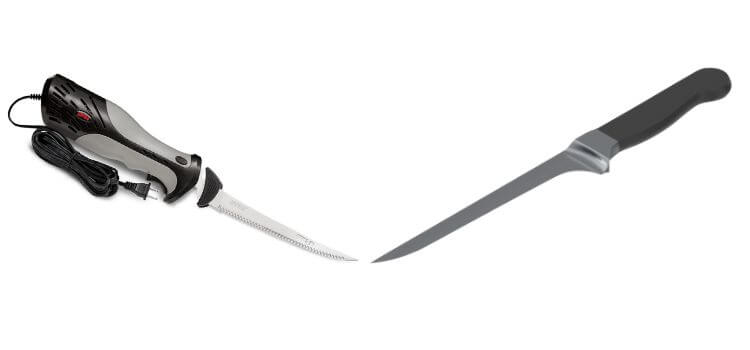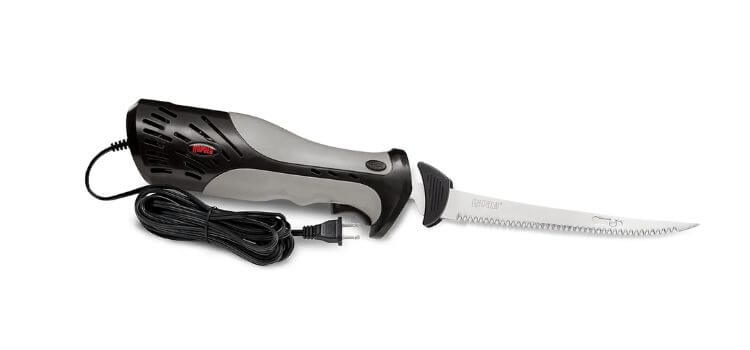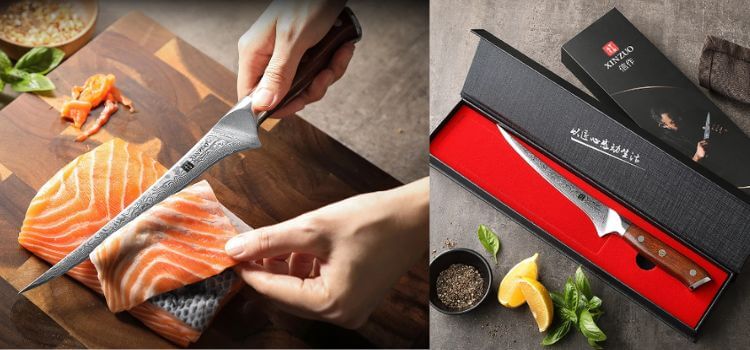As an Amazon Associate, I earn from qualifying purchases

The debate between electric fillet knives and traditional counterparts in kitchen tools has sparked curiosity among culinary enthusiasts. Both options present distinct advantages and disadvantages, making it essential to delve deeper into their differences to make an informed choice.
This article seeks to offer a comprehensive comparison between electric fillet knives and traditional knives. shedding light on their performance, usability, and overall impact on your culinary experience.
Whether you’re a seasoned chef seeking efficiency or a home cook looking to enhance your filleting skills, understanding the nuances of these two knife types will undoubtedly sharpen your cooking game.
What is an Electric Fillet Knife?

Electric fillet knives are specialized kitchen tools designed to make the filleting process faster and more efficient. They come with an electric motor, which powers the blade, allowing it to move back and forth rapidly to cut through meat or fish quickly. These knives usually feature a serrated blade that can be effortlessly detached for cleaning and maintenance.
Electric Fillet Knifes Basic Statistics:
- Average price range: $50-$100
- Weight: 1-2 pounds
- Length: 7-9 inches
Pros of Electric Fillet Knifes
- Speed: One of the most significant advantages of an electric fillet knife is its speed. The motor-powered blade can slice through fish or meat in mere seconds, saving you both time and work.
- Precision: Electric fillet knives come with adjustable blades, allowing you to choose different lengths and angles for precise cuts. This feature makes them ideal for delicate filleting tasks that require precision and finesse.
- Ease of use: The motorized blade does most of the work, making it easier to fillet large quantities of fish or meat without exerting too much pressure on your hand and wrist muscles. This feature also makes them an excellent option for those with arthritis or other hand mobility issues.
Cons of Electric Fillet Knifes
- Cost: Electric fillet knives can be more expensive compared to regular knives, which may be a deterrent for some.
- Maintenance: The detachable blades require regular cleaning and sharpening, which may seem daunting for those not used to the maintenance routine of these specialized kitchen tools.
- Noise and vibration: The electric motor can produce noise and vibrations, which may take some getting used to for those used to the quiet and smooth operation of regular knives.
Key Points To Consider About Electric Fillet Knife
- Comfortable
- Relaxed grip
- Fatigue-free filleting,
- Quicker and easier
- Fast
What is a Regular Fillet Knife?

Regular fillet manual or traditional knives are the go-to option for most home cooks and professional chefs. They come in various sizes and shapes, but typically have a long, thin blade with a sharp edge and a pointed tip. The blade is usually made of stainless or high-carbon steel and requires regular sharpening to maintain its effectiveness.
Regular Fillet Knifes Basic Statistics:
- Average price range: $10-$50
- Weight: 0.5-1 pound
- Length: 6-9 inches
Pros of Regular Fillet Knifes
- Versatility: Regular fillet knives can be used for various tasks, such as mincing, slicing, and dicing.
- Affordability: Regular knives are more cost-effective and readily available in most kitchen stores than electric fillet knives.
- Ease of maintenance: Regular knives do not require specialized maintenance, making them a convenient option for those who prefer low-maintenance kitchen tools.
Cons of Regular Fillet Knifes
- Effort and time: Using a regular fillet knife requires more effort and time than an electric one. This aspect can be challenging for those with hand or wrist issues or who must fillet large quantities of fish or meat.
- Less precision: Regular knives may not offer the same level of precision as electric ones, making them less suitable for delicate filleting tasks.
Key Points To Consider About Regular Fillet Knife
- Versatile
- Affordable
- Low maintenance
- Time-consuming
Electric Fillet Knife vs Regular: Which is Better?
Efficiency and speed
Electric fillet knives undoubtedly have an edge over regular ones in terms of efficiency and speed. The motor-powered blade allows for faster and more precise cutting, making them ideal for those who need to fillet large quantities of fish or meat regularly. However, regular knives can still be efficient if used correctly, and many cooks prefer the control they have with a manual blade.
Precision and control
Electric fillet knives offer more precision and control due to the adjustable blades and motorized operation. However, regular knives can also provide high precision with the right technique and skills. The crucial distinction lies in the operational method, with electric knives providing a more effortless cutting experience.
Impact on filleting quality and results
Both electric and regular fillet knives can produce high-quality results, but the method of operation and individual skills play a significant role. Electric knives may offer more consistent results due to their steady motorized blade movement, while regular knives rely on the user’s technique and experience.
Maintenance and Durability: Electric Fillet Knife vs Regular

Maintenance requirements for electric fillet knives
Electric fillet knives require regular maintenance, including cleaning and sharpening the blade. The detachable feature of the blades makes it easier to clean them thoroughly and ensure they are free from any food debris affecting their performance.
- Cleaning: Electric fillet knives should be cleaned after each use, preferably with warm, soapy water and a soft cloth or brush. It is essential to dry the blade thoroughly before storage to prevent rust.
- Sharpening: The blades of electric knives need sharpening regularly, depending on how frequently they are used. Using an electric knife sharpener or taking it to a professional is recommended for best results.
Maintenance requirements for regular fillet knives
Regular fillet knives also require some maintenance, although not as extensive as electric ones. As with any other kitchen knife, regular ones should be cleaned after each use and sharpened regularly to maintain their sharpness.
- Cleaning: Regular fillet knives should also be cleaned after each use with warm, soapy water and dried thoroughly before storage.
- Sharpening: Regular knives need sharpening regularly; the frequency depends on how often they are used and the blade type. For optimal results, it is recommended to either use a sharpening stone or consult a professional.
Cost considerations and overall value proposition
Electric fillet knives are typically more expensive than regular ones, but the added speed and efficiency can make them a worthwhile investment for those who frequently use them. On the other hand, regular fillet knives generally have a lower cost and offer versatility. The cost consideration should also include maintenance requirements and the potential lifespan of each type of knife.
Conclusion
Electric and traditional fillet knives each have their advantages and drawbacks. Ultimately, the best choice hinges on individual preferences and specific needs. Electric fillet knives offer speed, precision, and convenience, while regular ones are versatile, affordable, and require less maintenance.
Whichever type you choose, proper handling and maintenance will ensure that your knife serves you well for years to come. So, choose the one that fits your needs and budget, and happy filleting!
As an Amazon Associate, I earn from qualifying purchases
Pingback: Petty Knife vs Paring Knife